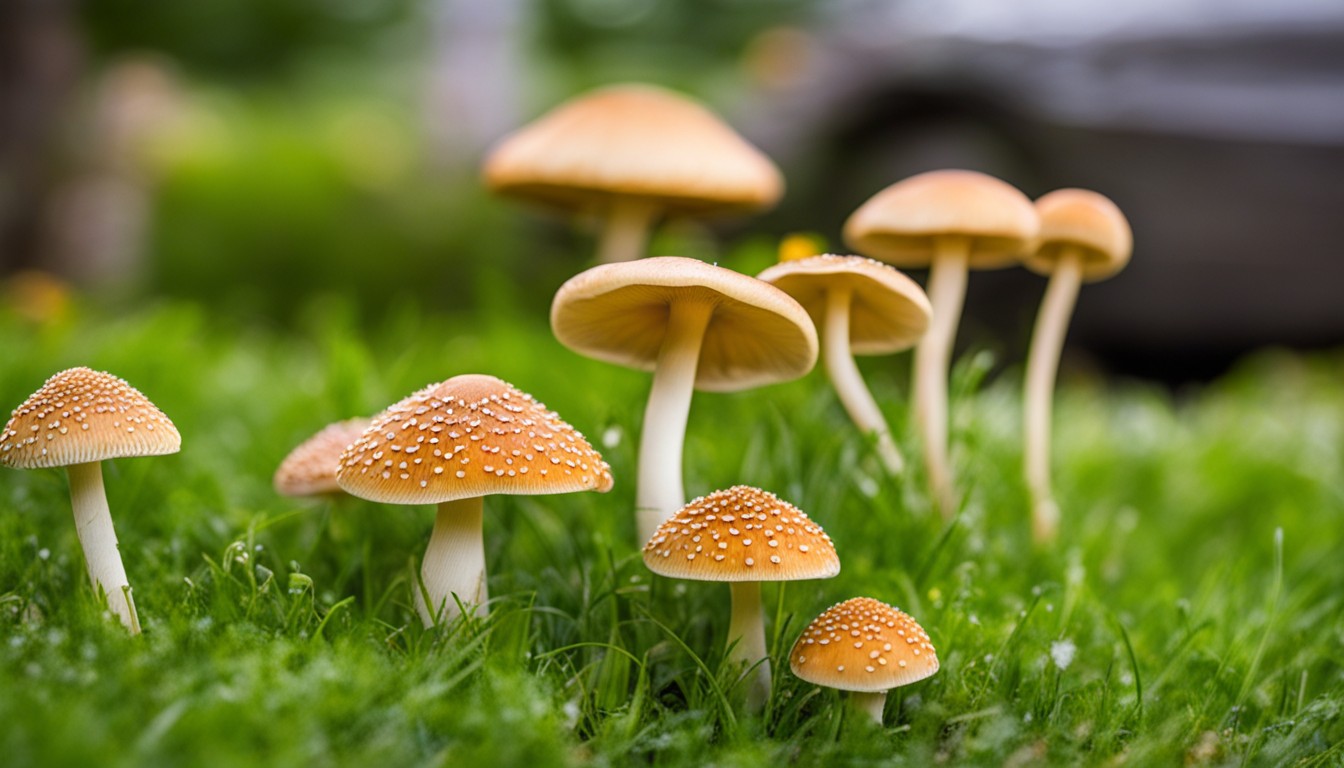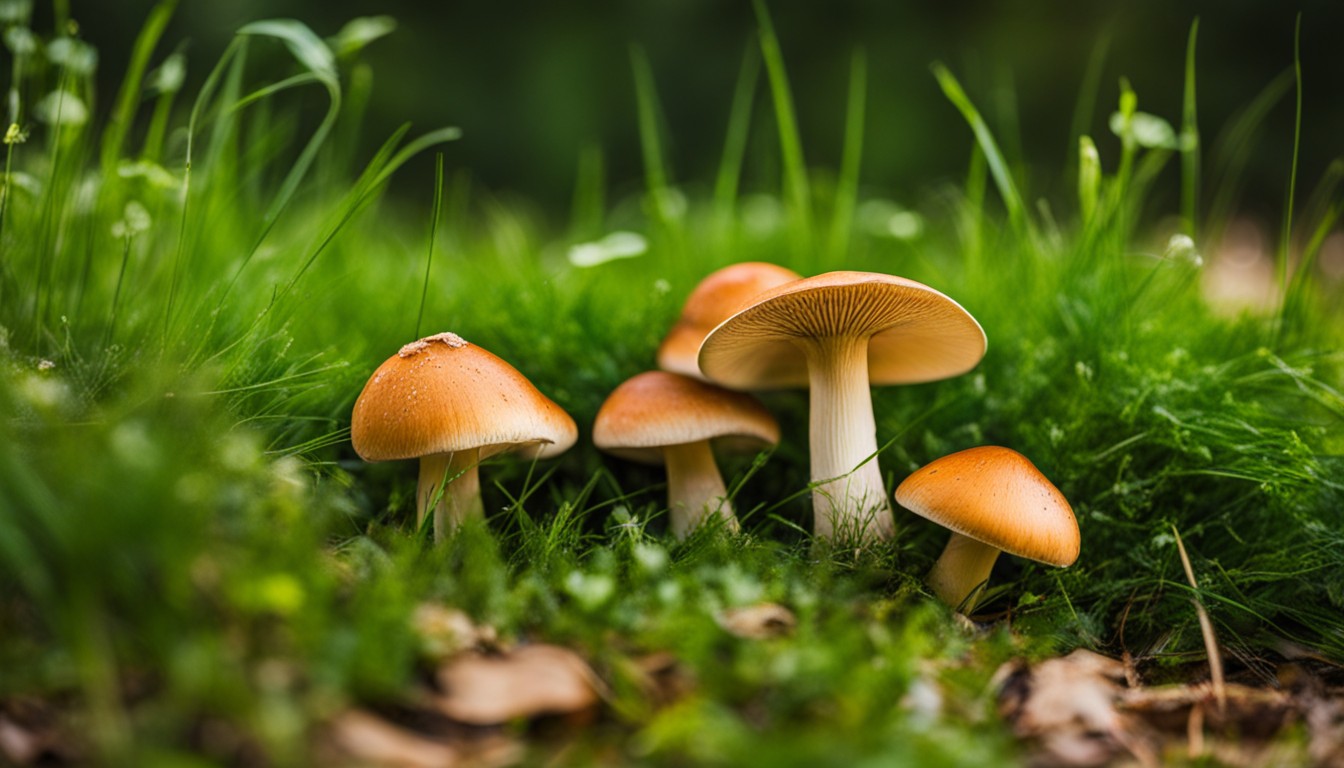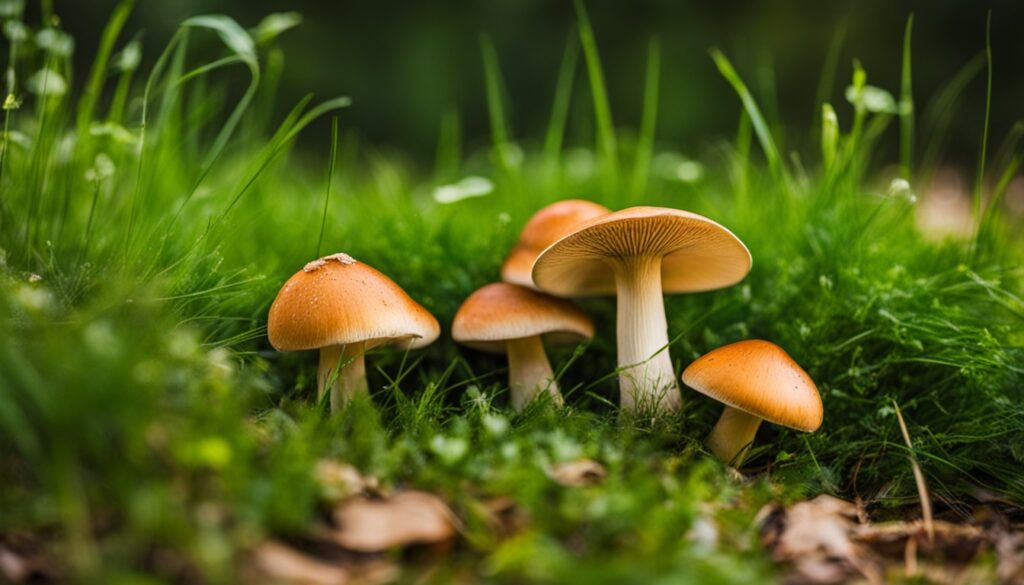Mushrooms in Texas lawns can be a common sight, but it’s important to know how to identify them and manage their presence. With their diverse shapes, sizes, and colors, identifying mushrooms can be challenging, but certain characteristics can help distinguish between edible and toxic varieties. Once identified, various methods can be employed to manage mushrooms in lawns, including improving drainage, reducing shade, and implementing proper lawn care practices. By understanding the basics of mushroom identification and employing effective management strategies, homeowners can maintain a healthy and beautiful lawn in Texas.
Why Are Mushrooms Growing in My Texas Lawn?
Remedying fungal growth in your yard begins with understanding why mushrooms are appearing in your Texas lawn. It’s more than just an aesthetic issue, as these fungal fruiting bodies tell a tale of underlying conditions in your soil.
Stepping behind the botany curtain, mushroom growth in your lawn occurs due to a combination of moisture, organic matter, and shade. Broadly speaking, these fungi thrive and multiply under these conditions, signaling the need for a comprehensive yard care approach.
Understanding the Role of Fungi
Fungi are often misunderstood organisms. Despite their daunting sight, they play an essential role in soil health by breaking down organic matter into nutrients that plants can use effectively. They’re Mother Nature’s composting system, contributing to the health of the ecosystem.
Fungi, including mushrooms, are pivotal in soil health, acting as Mother Nature’s composting system while also signaling potential lawn problems and decomposition activity.
However, not all fungi are friends to your garden. While they are essential to soil health, an overabundance can smother and kill your plants. It’s a delicate balancing act that needs careful monitoring for optimal lawn health.
Understanding the role fungi play in your garden can help distinguish between a healthy and an unhealthy lawn. A flourish of mushrooms may signify a vigorous ecosystem, but too many can indicate an underlying soil or drainage issue.
Mushrooms, a product of fungi, are also indicators of a long-forgotten organic material under your lawn’s surface. From tree roots to buried logs, mushrooms help degrade these materials to enrich your soil. They are a sign that your lawn is alive and functioning.
Factors That Promote Mushroom Growth
Mushrooms, as part of the fungi kingdom, flourish in specific conditions—moist, rich, and slightly acidic soils often stimulate their growth. When your lawn provides such hospitable environments, expect a mushroom bloom. Another contributory factor is dampness. Damp conditions, resulting from excessive watering or heavy precipitation, encourage mushroom sprouts. Hence, if your Texas lawn regularly witnesses standing water post-rain, mushrooms will likely set base.
Undeniably, gardens aren’t devoid of life—they are flourishing ecosystems. An abundance of organic matter, such as leaves, grass clippings, and old tree stumps, fuels mushroom growth. This happens due to the mycelium (the vegetative component of a fungus) feeding on these materials. If you notice an increased mushroom population, inspect your lawn for this surplus organic debris,
Dead roots below the surface can also invite mushroom colonies. As part of nature’s recycling system, fungi thrive by breaking down dead or decaying plant material in soil, decomposing it into nutrients beneficial for other plants. In this way, a mushroom’s presence can be an indication of a healthy lawn ecosystem, albeit an aesthetically unpleasing one.
Lastly, insufficient sunlight, combined with compacted soil or poor drainage, can create prime mushroom habitat in your Texas lawn. A dense canopy of trees or shrubbery can inhibit sun exposure while a tightly packed soil can retain too much moisture—factors together catalyzing mushroom proliferation.
Common Types of Lawn Mushrooms in Texas
In the vastness of Texas lawns, an array of mushrooms manifests, each distinct in characteristics and effects. A diligent classification of these fungi is imperative to lawncare.
Among the types spotted frequently in Texas lawns include fairy ring mushrooms, puffballs, and the potentially poisonous death cap – a harmless look-alike of the edible paddy straw mushroom.
Identifying Mushroom Species
Identifying mushroom species flourishing in your Texas lawns is an insightful place to start for effective management. It requires a keen eye and a basic understanding of their distinct features.
- Pay attention to the mushroom’s color and size
- Take note of the shape and structure of the mushroom, including its cap
- Consider the overall environment where it is growing
- Note if any spore prints or changes in the lawn are present
- Consult a comprehensive field guide to Texas fungi when in doubt
Edible vs. Toxic Mushrooms
In Texas lawns, distinguishing between edible and toxic mushrooms is a crucial task. This task is simplified by understanding certain mushroom traits. Let’s delve deeper into the mycology of Texas lawn mushrooms now.
- Use a field guide: An updated field guide could indicate the common edible and toxic mushroom varieties in Texas.
- Examine the color and smell: Edible mushrooms often have a mild or pleasant smell and consistent color.
- Check for a ring: Edible mushrooms aren’t likely to have a ring around the stem.
- Look at the gills: Poisonous mushrooms often have closely spaced gills.
- Run a spore print test: The color of the spores can indicate whether a mushroom is toxic or edible.
- When in doubt, do not eat: If you are unsure of a mushroom’s edibility, better to err on the side of caution and avoid consumption.
The Risks Associated with Lawn Mushrooms

Lurking within the seemingly harmless growths adorning your Texas lawn, potential dangers from toxic mushroom species could pose significant threats to both human and pet safety.
With our lawns potentially hosting invisible enemies in the form of hazardous fungi, managing and mitigating the risks of lawn mushrooms becomes a critical aspect of Texas residential lawn care.
Poisonous Mushrooms and Pet Safety
A real concern for pet owners in Texas is the possibility of our furry friends consuming toxic mushrooms from lawns. The ingestion of some species can lead to severe health problems and, in the worst cases, could prove fatal. Awareness and early identification of these hazardous fungi areessential steps to maintaining pet safety.
Poisonous mushrooms growing in Texas lawns might appear harmless but pose a significant risk if consumed by pets. It’s crucial to educate oneself on the various species and their toxicity levels, hence avoiding potential health hazards. Opting for professional advice when in doubt is always a good measure.
Potential Health Concerns for Humans
Lawn mushrooms pose potentially severe health threats, particularly due to ingestion or direct contact with poisonous varieties. This risk is exacerbated when an individual cannot accurately distinguish between toxic and non-toxic species.
Moreover, even non-poisonous mushroom spores may cause allergic reactions or respiratory problems when inhaled. It’s, therefore, vital for Texas residents to understand these health impacts to ensure their wellbeing while enjoying outdoor spaces.
Effective Techniques for Managing Lawn Mushrooms
Untamed fungus can compromise lawn health, but you can regain control using tried-and-tested techniques. Effective anti-fungal treatment requires a two-pronged approach: fungicide for immediate relief and a long-term commitment to lawn care for sustainable results.
Addressing a mushroom problem is no small feat. It demands using practical strategies, such as consistent use of appropriate fungicides and non-chemical methods, like maintaining adequate soil drainage. It is vital to strike a balance between immediate resolution and long-term prevention in your management plan.
Fungicide and Chemical Treatments
Strategic utilization of fungicides may effectively curb lawn mushroom growth. Using these in specifically infested areas in your Texas lawn, rather than blanket applications, can help protect beneficial fungi while targeting the issue.
The expertise to properly apply these treatments is critical. Misuse may harm non-target organisms, leading to adverse ecosystem impacts.
Specialized chemical treatments play a significant part in mushroom management. These treatments target the specific fungi species responsible for the mushroom outbreak, ensuring the treatment is as effective as possible.
Professional guidance is recommended for these treatments. They’ll ensure the correct and minimal usage necessary, reducing environmental impact and maximizing effectiveness.
Non-Chemical Methods for Mushroom Control
Harnessing the power of nature, certain non-chemical control strategies can be instrumental in managing lawn mushrooms, while also maintaining a green, healthy yard in Texas.
- Promote natural predators of mushrooms such as birds and small insects to your yard, as they aid in the control of mushroom populations.
- Physically removing the mushrooms — by mowing or hand plucking before they release spores — can limit their spread. However, remember to wear gloves to avoid exposure to potentially toxic varieties.
- Try a low-nitrogen, high-phosphorus fertilizer. It reduces the food source of mushrooms without damaging your lawn.
- Adjust your watering schedule. Mushrooms thrive in wet conditions. Frequent, shallow watering encourages mushroom growth, whereas infrequent, deep watering promotes grass roots and discourages mushrooms.
- Dethatch your lawn. Thatch — the layer of dead grass, roots, and debris on your lawn’s surface — makes an ideal environment for mushrooms. Regularly removing it can suppress mushroom growth.
- Aerate compacted soil to improve drainage and make it less conducive to mushroom spread.
Preventative Measures to Minimize Mushroom Growth

Careful lawn maintenance, which may include regular mowing, raking, and fertilization, forms a solid frontline defense against mushroom invasions.
Maintaining soil drainage, reducing lawn shade and dampness are other reliable preventive measures to curtail mushroom growth on Texas lawns.
Proper Lawn Maintenance and Fertilization
Adopting an effective lawn care routine, including strategic fertilization, can significantly decrease the likelihood of mushroom growth in Texas lawns. Healthy, well-nourished grass can compete more effectively with fungi, reducing their spread and dominance.
- Incorporate practices like weekly mowing, ensuring the grass isn’t too short, as it helps conserve soil moisture and prevent a dry, stressed-out lawn.
- Use a proper schedule for watering your lawn, ideally in the early morning hours, to avoid excessive soil saturation which mushrooms love.
- Choose a suitable fertilizer for your lawn type. Nitrogen-rich fertilizers help grass grow, limiting the organic material mushrooms feed on.
- Avoid over-fertilization, which can create favourable conditions for mushroom growth.
- Rotate or thatch your lawn regularly, this helps break down organic material quickly, denying mushrooms their food source.
Improving Soil Drainage
Improving soil drainage is crucial in managing the growth of mushrooms in lawns in Texas. Excess moisture fosters fungi proliferation, thus a well-drained lawn helps keep mushrooms at bay.
- Aerate your lawn to enhance permeability and reduce mushroom-friendly, compacted soil.
- Create a gradual slope in your yard to channel water away from wet areas.
- Consider adding a dry well or rain garden to capture and disperse water.
- Use organic matter or sand to improve the texture of clay-heavy soil.
- Assess your watering schedule. Frequent, shallow watering can contribute to damp conditions ideal for mushrooms.
Reducing Lawn Shade and Moisture
Appropriate balance of lawn shade and moisture is critical in curbing mushroom proliferation. Excessive moisture and shade provide ideal conditions for fungi, including mushrooms, to thrive. Thus, managing these elements can drastically reduce your property’s mushroom growth.
Pruning overgrown trees and removal of debris that create shade can provide check and balance in your lawns. It encourages quick evaporation of moisture, decreasing the chances of mushroom formation.
Good irrigation practices also play a pivotal role in maintaining lawn moisture levels. Over-watering creates a conducive environment for fungi. Adequate watering, ideally early morning, allows the sun to dry the soil surface, making it less inviting for mushroom growth.
When to Consult a Professional
Acknowledging the moment to seek professional help isn’t always straightforward. If persistent mushrooms appear despite your careful control efforts, this signals that your lawn may be facing a deeper fungal issue that requires the intervention of a lawn care specialist.
In situations where mushrooms continuously reappear or cover vast sections of your lawn, this might be an indication of a more serious underlying issue. Professional help can provide expert analysis and effective solutions to manage and prevent further mushroom growth.
Signs of a More Serious Lawn Fungal Issue
A noticeable increase in the proliferation of mushrooms in your garden can signal a serious fungal problem. If you observe an explosion of these capped intruders all across your lawn, it may be a distress signal, indicating a more profound issue beneath the soil.
Certain mushrooms, particularly the Lawn Inky Cap and the Fairy Ring mushrooms, are notorious for causing circular patches of discolored or dying grass – an alarming sign of severe fungal infestation.
Early detection plays a pivotal role in controlling extensive fungal invasions. Be on the lookout for symptoms such as mushrooms clustering around tree roots or multiplying excessively, faded grass patches, or the presence of foul odors emanating from your lawn.
Do not ignore your lawn’s pleas for help. If you encounter any of these signs or witness a scenario where, despite your efforts, the mushroom intrusion persists, it signifies a call for professional intervention.
Getting Expert Advice on Mushroom Management
Gaining insight from professionals is crucial in handling lawn mushrooms effectively. Your local landscape or agricultural extension office can offer invaluable advice tailored to your specific situation.
The expertise of professionals in the field is beneficial not merely for mushroom management but also for maintaining the overall health of your lawn. A holistic understanding of lawn care goes a long way to prevent future mushroom infestations.
When traditional methods fail, an experienced lawn care expert can provide alternate solutions. Using their extensive knowledge of lawn ecosystems, they effectively tackle stubborn mushroom growth.
Remember, every lawn is unique and may require different care methods. Seeking expert advice ensures that the mushroom management strategies employed are perfectly suited to your lawn, contributing to its long-term health and vitality.
Mushrooms in Texas Lawns: Frequently Asked Questions
Introduction: Get answers to commonly asked questions about mushrooms in Texas lawns, including their roles, common types, associated risks, effective management techniques, and the importance of professional guidance.
What is the role of mushrooms in Texas lawns?
Mushrooms play a vital role in the ecosystem of Texas lawns. They aid in the decomposition of organic matter, such as dead plant material and decaying roots, which helps enrich the soil and promote nutrient cycling.
What are some common types of mushrooms found in Texas lawns?
Texas lawns are home to a diverse range of mushroom species. Common types found include the Puffball mushroom, Fairy Ring mushroom, Amanita mushroom, and many others. Each type exhibits unique characteristics, shapes, and colors.
Are all mushrooms in Texas lawns safe to consume?
Not all mushrooms found in Texas lawns are safe for consumption. It is essential to exercise extreme caution when foraging for mushrooms, as many toxic varieties closely resemble edible ones. Unless you are an experienced mycologist, it is best to avoid consuming wild mushrooms.
How can I effectively manage mushrooms in my Texas lawn?
To manage mushrooms in your Texas lawn, several strategies can be employed. Start by improving drainage to reduce excess moisture, as mushrooms thrive in damp environments. Additionally, reducing shade by trimming overhanging branches or strategic tree pruning can help discourage mushroom growth. Regularly mowing your lawn, removing mushroom fruiting bodies, and their underlying mycelium can also aid in their management.
What are the potential risks associated with mushrooms in Texas lawns?
While most mushrooms found in Texas lawns are harmless, there are potential risks associated with consuming unidentified species. Some toxic mushrooms can cause severe gastrointestinal distress or even organ failure. It is crucial to educate yourself about mushroom identification or consult an expert before consuming wild mushrooms.
Should I consult a professional for mushroom identification and management?
If you are unsure about mushroom identification or face persistent mushroom-related issues in your lawn, it is highly recommended to consult a professional mycologist or an experienced horticulturist. They can provide accurate identification, offer guidance on managing mushrooms in your lawn, and ensure your safety when dealing with potentially toxic varieties.
Conclusion
Lawn mushrooms in Texas can be both an aesthetic issue and a health concern. Knowledge, prevention, and control are the three integral sections in effectively managing these fungi in your turf.
A hands-on yet considerate approach to lawn health, paired with adequate knowledge of mushrooms, provides a foundation for keeping these unexpected guests under control while preserving the wellbeing of your landscape.
- Know your mushrooms: Familiarize yourself with the various types common to Texas.
- Take preventative measures: Conduct regular lawn maintenance, improve soil drainage, and mind the shade and moisture levels.
- Monitor pet safety: Be aware of the potential dangers of poisonous mushrooms to pets.
- Consider chemical and non-chemical controls: Use fungicides or physical removal methods to manage mushroom growth.
- Consult a professional when necessary: If a serious fungal issue appears to develop, seek expert advice.

